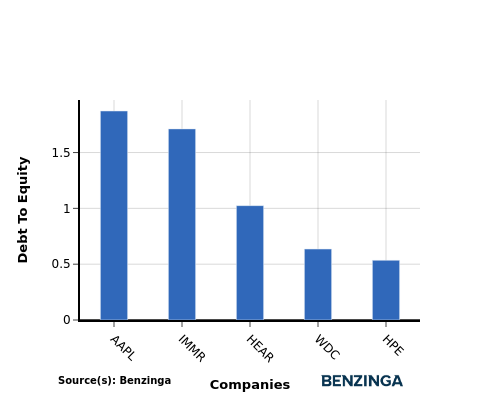In today's fast-paced and highly competitive business world, it is crucial for investors and industry followers to conduct comprehensive company evaluations. In this article, we will delve into an extensive industry comparison, evaluating Apple AAPL in relation to its major competitors in the Technology Hardware, Storage & Peripherals industry. By closely examining key financial metrics, market standing, and growth prospects, our objective is to provide valuable insights and highlight company's performance in the industry.
Apple Background
Apple is among the largest companies in the world, with a broad portfolio of hardware and software products targeted at consumers and businesses. Apple's iPhone makes up a majority of the firm sales, and Apple's other products like Mac, iPad, and Watch are designed around the iPhone as the focal point of an expansive software ecosystem. Apple has progressively worked to add new applications, like streaming video, subscription bundles, and augmented reality. The firm designs its own software and semiconductors while working with subcontractors like Foxconn and TSMC to build its products and chips. Slightly less than half of Apple's sales come directly through its flagship stores, with a majority of sales coming indirectly through partnerships and distribution.
| Company | P/E | P/B | P/S | ROE | EBITDA (in billions) | Gross Profit (in billions) | Revenue Growth |
|---|---|---|---|---|---|---|---|
| Apple Inc | 37.81 | 61.01 | 9.06 | 23.83% | $32.5 | $43.88 | 6.07% |
| Hewlett Packard Enterprise Co | 15.67 | 1.30 | 1.01 | 2.34% | $1.23 | $2.44 | 10.11% |
| Western Digital Corp | 73 | 1.97 | 1.55 | 4.28% | $0.86 | $1.55 | 48.91% |
| Super Micro Computer Inc | 16.50 | 3.55 | 1.34 | 6.68% | $0.4 | $0.6 | 37.87% |
| Pure Storage Inc | 119.60 | 11.65 | 6 | 2.52% | $0.08 | $0.54 | 10.91% |
| Eastman Kodak Co | 7.53 | 0.43 | 0.46 | 1.34% | $0.04 | $0.04 | -2.97% |
| Turtle Beach Corp | 50.90 | 3.11 | 0.94 | 3.3% | $0.01 | $0.03 | 59.51% |
| Immersion Corp | 4.95 | 1.24 | 1.76 | 13.41% | $0.03 | $0.06 | 1323.8% |
| AstroNova Inc | 17.58 | 1.21 | 0.75 | -0.34% | $0.0 | $0.01 | 14.12% |
| Average | 38.22 | 3.06 | 1.73 | 4.19% | $0.33 | $0.66 | 187.78% |
Upon a comprehensive analysis of Apple, the following trends can be discerned:
-
A Price to Earnings ratio of 37.81 significantly below the industry average by 0.99x suggests undervaluation. This can make the stock appealing for those seeking growth.
-
It could be trading at a premium in relation to its book value, as indicated by its Price to Book ratio of 61.01 which exceeds the industry average by 19.94x.
-
With a relatively high Price to Sales ratio of 9.06, which is 5.24x the industry average, the stock might be considered overvalued based on sales performance.
-
The Return on Equity (ROE) of 23.83% is 19.64% above the industry average, highlighting efficient use of equity to generate profits.
-
The company exhibits higher Earnings Before Interest, Taxes, Depreciation, and Amortization (EBITDA) of $32.5 Billion, which is 98.48x above the industry average, implying stronger profitability and robust cash flow generation.
-
With higher gross profit of $43.88 Billion, which indicates 66.48x above the industry average, the company demonstrates stronger profitability and higher earnings from its core operations.
-
The company is witnessing a substantial decline in revenue growth, with a rate of 6.07% compared to the industry average of 187.78%, which indicates a challenging sales environment.
Debt To Equity Ratio

The debt-to-equity (D/E) ratio is a measure that indicates the level of debt a company has taken on relative to the value of its assets net of liabilities.
Considering the debt-to-equity ratio in industry comparisons allows for a concise evaluation of a company's financial health and risk profile, aiding in informed decision-making.
When evaluating Apple alongside its top 4 peers in terms of the Debt-to-Equity ratio, the following insights arise:
-
In terms of the debt-to-equity ratio, Apple has a relatively higher level of debt of 1.87 compared to its top 4 peers.
-
This could be seen as a potential risk factor for the company, as a higher debt burden may increase financial vulnerability.
Key Takeaways
For Apple in the Technology Hardware, Storage & Peripherals industry, the PE, PB, and PS ratios indicate that the stock is relatively undervalued compared to its peers. However, the high ROE, EBITDA, gross profit, and low revenue growth suggest that Apple is efficiently utilizing its resources and generating strong profits, despite slower revenue growth. Overall, Apple's financial performance is solid, with room for potential growth in the future.
This article was generated by Benzinga's automated content engine and reviewed by an editor.
Edge Rankings
Price Trend
© 2025 Benzinga.com. Benzinga does not provide investment advice. All rights reserved.
Trade confidently with insights and alerts from analyst ratings, free reports and breaking news that affects the stocks you care about.